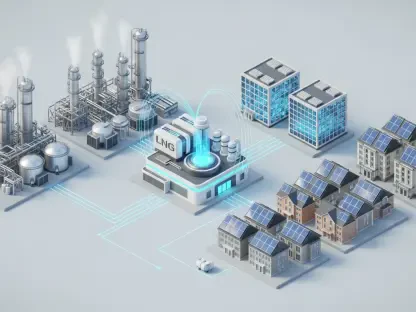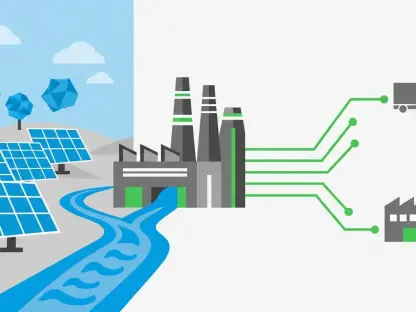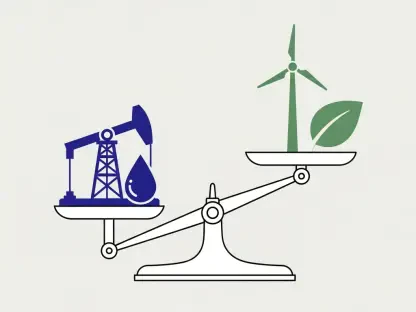Artificial Intelligence (AI) is rapidly advancing, and with it, the energy requirements to sustain its growth. From healthcare to automotive industry transformations, AI’s influence is wide-ranging. However, this progress comes at a considerable energy cost. As models grow more complex, the computational power required—and consequently, the energy consumed—increases exponentially. The key question now is: can Canada manage to meet these escalating energy demands in the future?
The Unparalleled Energy Demand of AI Technologies
AI in Various Sectors
Artificial Intelligence is revolutionizing various fields such as healthcare, automotive, and climate science. These applications require powerful computing capabilities that consume vast amounts of electricity. AI models like OpenAI’s ChatGPT and Google’s Bard serve as prime examples of generative AI systems that are energy-intensive. Training these models requires large-scale data processing, which translates to thousands of megawatt hours of electricity—similar to the energy consumed by mid-sized urban centers.
Beyond training, the operational side of AI is equally demanding. Simple processes, such as querying AI systems, consume substantial power. For instance, a single query to ChatGPT uses ten times the energy of a standard Google search. As millions of users interact with these AI systems daily, the total energy consumed grows significantly. This consumption pattern places immense pressure on current energy infrastructures, calling into question the sustainability of this rapid technological advancement. The broader implication is clear: the more AI applications penetrate everyday activities, the more urgent the need to address their substantial energy footprints becomes.
Heavy Energy Consumption
The energy requirements for AI are continuously on the rise, not only during the initial training phase but also during regular operations. Beyond the computationally heavy tasks of training and queries, running the models continually to meet real-time demands also consumes significant power. For instance, keeping AI systems updated with the latest data and ensuring their responsiveness to user needs are ongoing processes that draw heavily on electrical resources. The cumulative effect of these energy-consuming activities across millions of users is staggering, emphasizing the critical need for substantial, continuous energy input.
This scenario presents a formidable challenge, especially in regions where energy resources are already stretched thin. The exponential increase in AI-related power consumption underscores the demand for more resilient and scalable energy solutions. Without substantial improvements in energy efficiency and expanded resource planning, sustaining the growth and utility of AI technologies could become increasingly difficult. The persistent pressure on energy infrastructures necessitates robust solutions and innovative approaches to energy management and supply in order to keep pace with AI advancements.
The Role of Data Centers: Energy Hubs of the Digital Age
Exponential Growth
Data centers form the operational backbone of AI technologies, playing a critical role in managing and processing the vast volumes of data that AI systems rely on. As AI services become more prevalent, the energy consumption of these data centers continues to grow exponentially. A report by the International Energy Agency (IEA) underlines that AI and data center operations collectively account for 1-2% of global electricity consumption. This figure is not static; it is projected to surge by an eye-watering 160% by 2030. Addressing this rising demand requires not just adding more capacity but also innovating current energy management practices to handle the intensified load efficiently.
As data centers scale up to accommodate the increasing needs of AI, the challenges become multifaceted. Capital investments for infrastructure expansion are crucial, but these need to be complemented by the development of advanced technologies and more energy-efficient practices. Simply increasing the number of data centers is not a viable long-term solution due to environmental concerns and economic constraints. Thus, one of the critical areas of focus for both the AI and energy sectors is to develop new methodologies that optimize power usage while still delivering the performance required by intricate AI processes.
Challenges in Scaling
The growing power needs of data centers necessitate expansive and sophisticated energy management strategies to ensure sustainability. Scaling these operations to align with future demands poses numerous challenges, including securing substantial capital for infrastructure improvements and spearheading the development of new, energy-efficient technologies. Successful scaling also involves adopting best practices that minimize energy wastage while maximizing operational efficiency. Without such measures, the energy consumption of data centers may grow unsustainably, placing further strain on already stretched power grids and potentially leading to significant operational bottlenecks.
Moreover, addressing these challenges requires a collaborative approach involving governments, private sector stakeholders, and energy providers. Public policies must encourage and facilitate investments in energy infrastructure projects, while private enterprises need to prioritize research and development in sustainable technologies. Achieving this balance is essential to creating a scalable, resilient energy infrastructure capable of meeting the surging demands of data centers. Such efforts will be pivotal in ensuring that the growth of AI technologies does not outpace the ability to provide reliable, efficient energy solutions, thereby safeguarding both technological advancement and energy security.
Canada’s Energy Security: Current State and Future Projections
Historical Reliance and Emerging Strains
Canada has historically relied on its abundant hydroelectric and nuclear power resources to meet its energy needs. These sources have provided a stable and reliable supply of electricity for decades. However, several emerging factors are beginning to strain these previously dependable resources. Population growth and economic electrification are driving increased energy consumption, while climate change is introducing unpredictability into weather patterns that affect hydroelectric power generation. As these pressures mount, it becomes increasingly clear that Canada’s existing energy infrastructure may not be fully equipped to handle the escalating demands of a rapidly advancing technological landscape.
Compounding these challenges are the aging infrastructure and the geopolitical considerations that impact the energy sector. Many of Canada’s hydroelectric dams and nuclear plants were built decades ago and now require significant maintenance or upgrades to continue operating at optimal levels. In addition, as the country looks to achieve its ambitious net-zero emissions targets by 2050, there is an added layer of complexity. Transitioning to cleaner energy sources while simultaneously expanding capacity to meet growing demands will require strategic planning, substantial investments, and innovative technological solutions. The pressing need for a comprehensive approach to energy security is more urgent than ever before.
Regional Vulnerabilities
Certain regions in Canada are particularly vulnerable to the impending energy shortages. In British Columbia, the demand for hydroelectric power is expected to rise by 15% over the next six years, straining the province’s capacity to generate and distribute electricity. Manitoba faces a potential shortfall by 2029 due to increasing power needs, prompting concerns about the region’s ability to sustain its energy supplies. Meanwhile, Ontario is in a race against time to establish new nuclear plants by 2029 to avert an anticipated energy crisis. These regional disparities in energy security underscore the urgent need for targeted, strategic energy planning and infrastructure development.
Addressing these vulnerabilities requires a multifaceted approach. First, substantial investments in renewable energy projects are essential to diversify and expand the energy supply. Second, upgrading existing infrastructure to improve efficiency and capacity can help mitigate potential shortfalls. Third, regional energy policies need to be aligned with broader national strategies to ensure cohesive and effective responses to the looming energy challenges. By adopting a proactive stance and leveraging technological advancements, Canada can enhance its energy resilience and sustainability, securing a stable supply of electricity for its growing AI sector and broader economic needs.
Policy and Strategic Initiatives: Meeting Future Energy Demands
Federal Government’s Net-Zero Ambition
The Canadian federal government’s commitment to achieving net-zero emissions by 2050 adds an additional layer of complexity to the already challenging landscape of energy demands. This ambitious goal requires Canada to drastically reduce its carbon footprint while simultaneously expanding its electricity supply to meet future needs. Achieving net-zero emissions will necessitate doubling the country’s electricity generation capacity within the next 25 years. Such a monumental task underscores the need for robust policy measures, substantial investments in energy infrastructure, and comprehensive strategic planning. The intersection of these goals presents a unique challenge that must be navigated with precision and foresight.
To transition toward a net-zero future, the federal government must prioritize investments in renewable energy sources such as wind, solar, and hydroelectric power. These investments will not only help reduce greenhouse gas emissions but also provide a sustainable and reliable source of energy to support the growing demand from AI and other sectors. Additionally, advancing energy storage technologies, improving grid infrastructure, and enhancing energy efficiency measures are critical components of a comprehensive strategy. By fostering innovation and collaboration among various stakeholders, including government agencies, private enterprises, and research institutions, Canada can pave the way for a sustainable energy future that aligns with its net-zero ambitions.
Effective Policy-Making
Addressing the intersecting challenges of AI’s energy needs and Canada’s energy security requires comprehensive and effective policy-making. Governments at various levels must prioritize energy infrastructure projects, encourage the adoption of renewable energy, and support technological innovations in the energy sector. Strategic initiatives that align with both AI advancements and sustainable energy practices are crucial for meeting future demands. Policymakers need to create an enabling environment that incentivizes investments in clean energy solutions and facilitates the development of cutting-edge technologies to optimize energy use and efficiency.
Effective policy-making involves a collaborative approach, bringing together diverse stakeholders to develop cohesive and forward-looking strategies. This includes implementing regulatory frameworks that promote energy efficiency, offering financial incentives for renewable energy projects, and fostering public-private partnerships to drive innovation. Additionally, policies should prioritize research and development efforts to advance sustainable energy technologies and address the unique challenges posed by the increasing energy demands of AI. By adopting a holistic and adaptive policy framework, Canada can ensure a resilient and sustainable energy infrastructure capable of supporting its technological growth and environmental stewardship goals.
AI as Both a Consumer and Contributor to Energy Solutions
AI’s Role in Energy Optimization
While AI’s rapid growth exacerbates energy challenges, its advanced capabilities can also play a pivotal role in addressing these issues. AI technologies have the potential to revolutionize energy optimization by assisting in data processing, system modeling, and formulating innovative solutions. For instance, AI can be used to analyze vast amounts of data to identify patterns and inefficiencies in energy consumption, enabling more informed decision-making. Furthermore, AI-driven algorithms can optimize the operation of energy systems, enhancing their efficiency and reducing overall energy use. These technologies offer promising avenues for achieving more sustainable energy management.
In addition to data analysis and optimization, AI can facilitate the integration of renewable energy sources into the power grid. By predicting energy generation from intermittent sources like wind and solar, AI can help balance supply and demand, ensuring a stable and reliable energy supply. Moreover, AI can enhance energy storage systems by optimizing the charging and discharging cycles, extending the lifespan of batteries and improving their efficiency. These applications demonstrate the dual role of AI as both a significant consumer of energy and a valuable tool in developing energy-efficient solutions. By leveraging AI’s capabilities, Canada can address its energy challenges while supporting the sustainable growth of its technological ecosystem.
Symbiotic Relationship
The relationship between AI and energy is inherently symbiotic, presenting both opportunities and challenges for sustainable development. As AI helps to craft solutions for energy efficiency, it concurrently escalates power consumption, contributing to overall demand. This duality calls for a balanced approach, where the benefits of AI-driven energy optimization are leveraged to offset its substantial power usage. By integrating AI into energy management systems, Canada can harness its potential to develop more efficient and sustainable energy solutions while mitigating the impacts of increased energy consumption.
To achieve this balance, it is essential to adopt a holistic perspective that considers the broader implications of AI’s energy demands. This involves investing in research and development to create more energy-efficient AI models and algorithms, as well as exploring alternative computing paradigms that reduce power consumption. Additionally, fostering collaboration between the AI and energy sectors can facilitate the sharing of best practices and the development of innovative solutions that address the unique challenges posed by this symbiotic relationship. By embracing a comprehensive strategy that aligns AI advancements with sustainable energy practices, Canada can navigate the complexities of this evolving landscape and ensure a resilient energy future.
The Path Forward: Strategic Development and Technological Innovations
Expanding Energy Supply
Canada must prioritize expanding its energy supply to meet the future demands of AI technologies. This involves investing in renewable energy sources, upgrading existing infrastructure, and developing new power plants. Such initiatives are essential to ensure that Canada can sustain the rapid growth of AI without compromising its energy security. Expanding the energy supply requires a multifaceted approach, encompassing both short-term and long-term strategies. In the short term, measures such as increasing energy efficiency and optimizing current resources can help alleviate immediate pressures. In the long term, substantial investments in renewable energy projects, grid modernization, and advanced storage solutions are critical to building a resilient and sustainable energy infrastructure.
A key component of expanding the energy supply is the diversification of energy sources. By reducing reliance on a single source and incorporating a mix of renewable options, Canada can enhance the stability and reliability of its energy grid. Integrating wind, solar, and hydroelectric power into the national grid not only supports environmental goals but also provides a buffer against fluctuations in individual energy sources. Additionally, investing in cutting-edge technologies such as smart grids and energy management systems can optimize the distribution and consumption of electricity, further bolstering Canada’s energy resilience. These efforts collectively contribute to a robust energy infrastructure capable of meeting the escalating demands of AI and other sectors.
Technological Innovations
Artificial Intelligence (AI) is advancing at an unprecedented rate, bringing significant transformations across various industries, from healthcare to automotive sectors. Yet, this rapid progress comes with a hefty energy price. As AI models become more intricate, the computational resources needed—and therefore the energy consumed—rise exponentially. The crux of the matter now is not just marveling at AI’s capabilities but also addressing the substantial energy demands that accompany this growth. Can Canada keep up with these increasing energy requirements? It’s a question of balancing innovation with sustainability. As AI technologies continue to evolve, they demand not only hardware and software advances but also energy solutions that are both efficient and environmentally friendly. The challenge lies in developing sustainable ways to power these technologies without compromising the growth and benefits AI brings to various sectors. This balance is crucial for maintaining progress without depleting resources or harming the environment, ensuring that the future of AI remains promising and sustainable.









